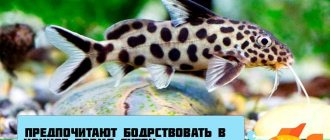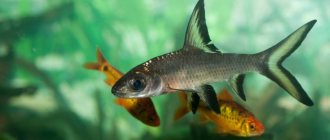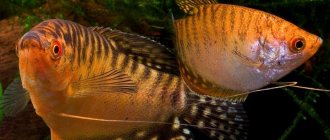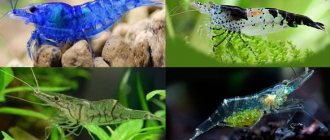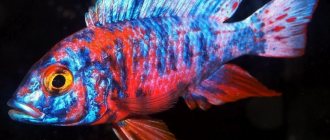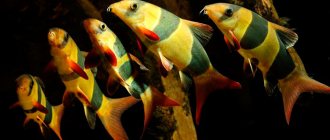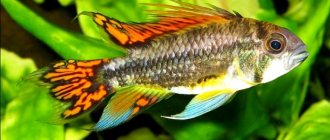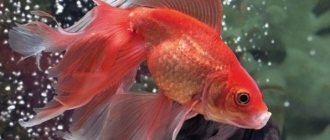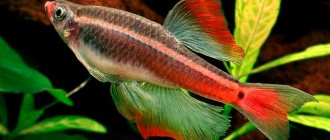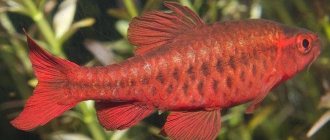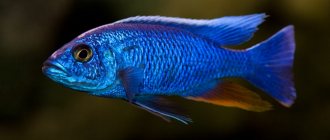4.9
(9)
The cichlid family holds a special place among aquarists. They stand out noticeably among representatives of the underwater fauna due to their bright natural color, peculiar disposition and habits. However, one of the brightest fish from this family is considered to be the blue dolphin. It attracts the attention of all aquarists, but, as a rule, only special cichlid lovers start it, because they have their own characteristics in care.
Description
Nannakara Electric Blue has an original blue neon color. Along the edge of the dorsal fin of each individual there is a pronounced golden or red stripe from tail to head.
Depending on the lighting, such fish may change color slightly. Some experts call nannakara turquoise because of the characteristic shade of its scales.
Blue neon
The eye color of a neon fish is red or orange.
Representatives of this species are characterized by an oblong body shape along with curved lines of the abdomen and back. The body itself is slightly compressed laterally. Its upper part is bordered by a long dorsal fin.
Types and breeds of angelfish
Among the angelfish, there are quite a lot of species and breeds that differ from each other in both body shape and size, as well as color. Some were formed naturally, while others were bred artificially.
Black angelfish. Another name for Ludwig's angelfish. It is distinguished by a very dark matte color, against the background of which, however, characteristic vertical stripes are visible. The main requirement for this breed is the absence of shiny scales; the fish should resemble a piece of black velvet.
Koi angelfish. It got its name due to the similarity of color to the famous Japanese koi carp - red, orange and black spots are scattered throughout the body on a white background. It is one of the most beautiful varieties of angelfish.
Blue angelfish. Very interesting fish, which have a blue tint against the background of the silver color typical of most angelfish. It is especially noticeable on the fins, which in this breed have a rounded shape at the ends. A very popular and beautiful breed.
White angelfish . Perhaps, it is this breed that is most worthy of being called an “angel fish”, because it has the color of a well-polished silver or even a mother-of-pearl shell.
Golden angelfish . Just like white, it does not have transverse stripes, but the overall shade of the body is light gold.
Photo: globallookpress.com
Red angelfish . An interesting breed, also devoid of dark stripes. But on the body there are areas painted in an intense red color, and scales may also be partially absent. To maintain bright colors, the fish must be given special food.
Angelfish Altum . Giants among angelfish, capable of growing up to 0.5 m in height in the wild. This wild form is slightly different from other fish with a more elongated muzzle and a rounded body. The stripes are very pronounced (both clear black and barely visible gray between them).
Angelfish glofish. A classic product of genetic engineering. By implanting the genes of bright coelenterates, geneticists were able to create fish painted in incredibly bright colors: crimson, pink and others (2).
Content
Fish of the Nannakara Blue Neon breed are hardy and unpretentious creatures, distinguished by their peacefulness and high immunity to external factors. They can be found in the collections of both experienced and novice amateur aquarists. These fish perfectly get used to and adapt to various characteristics of the aquatic environment.
Nannakara loves space. The volume of the aquarium is determined by the number of neighbors and their species. A 70-liter container is enough to house a couple of fish. But if they live with “neighbors”, then the volume should be more than 150 liters. We recommend equipping the aquarium itself with a lid.
It is advisable to arrange a habitat for the nannakara using all kinds of decorative accessories. For blue neon, these can be clay elements or grottoes of various sizes, as well as flat stones, driftwood, made of bog oak or mopane.
When setting up, it is imperative to ensure sufficient filtration and aeration of the water column in the aquarium. Without these devices, proper care for your neon fish will not be provided. In order for all individuals to be healthy and active, they must be in clean water that is sufficiently saturated with oxygen, so do not forget to periodically clean the aquarium.
There are no special water parameters for nannakara - it adapts to the prevailing environmental conditions. But you should start from average values: it is better to choose hard water with an acidity level in the range of 6–8 pH. Its temperature is set to +22 – +28 °C.
Any soil for an aquarium is also suitable. We advise you to give preference to these varieties:
- Coarse quartz river sand;
- Coral chips with marble;
- Dark gravel fraction 4 mm.
Nannakars do not touch plants, since they are not at all interested in excavating soil. Therefore, it is quite possible to add all kinds of living plants to the design of the aquarium at your discretion. It is important to select a spacious area, free from decorative elements, where neon fish will swim to their heart's content, as well as an area with densely placed underwater greenery - here they can hide if they feel danger or are simply afraid of something.
Electric blue
For the comfort of the inhabitants of the aquarium, its lighting should remain diffused, not too intense and bright.
Feeding the fish
Nannakara aquarium fish eat live food well, but they will not refuse high-quality dry food designed for representatives of the cichlid family. Moreover, in practice the latter is used more often, since it is very convenient.
If the diet includes dry food, it must certainly contain spirulina with pieces of pre-scalded vegetables. You can feed them cucumber, cabbage leaf or zucchini. Artemia or bloodworms are suitable for live food.
The peculiarity of this breed is its gluttony. Individuals actively drive away other inhabitants of the aquarium from their food, but even if the rules of the neighborhood are violated, they can feast on them.
Caring for angelfish fish
Of course, by entrusting its life to a person, a pet hopes for appropriate care. Firstly, the fish must be fed regularly. Secondly, you need to understand that they need oxygen to breathe, so the aquarium will need to be equipped with a compressor (by the way, this is why you should not place a tank with fish in the bedroom if you are a light sleeper - even the quietest compressor will not be able to work silently) and not Clean it less than once a week, changing a third of the water.
Photo: globallookpress.com
In their natural environment, angelfish live among dense algae, so make sure that there is live vegetation in the aquarium. It’s good if these are some kind of plants with long or wide leaves, planted in the ground (4). At the same time, part of the aquarium should be left free from plants, where the fish can frolic to their heart's content.
Angelfish are not jumping creatures, so it is not necessary to cover the aquarium.
Aquarium volume
Angelfish are unique fish in which their body height exceeds their length. It is not difficult to assume that they will first need a deep aquarium. Ideally, its depth should not be less than 50 cm. As for the volume, if you want to grow giants, stock up in advance on a huge aquarium of at least 100 liters for a couple of angelfish. In this case, your pets can grow to be the size of an average saucer. Accordingly, in a smaller volume they will remain small.
Water temperature
Like all natives of tropical and even equatorial rivers, angelfish prefer warm water, but they are not as thermophilic as, for example, discus fish. 22 - 25 °C is enough for them, but if the water cools down to 18 - 20 °C for some time, this does not mean that the fish will die immediately, but, of course, they will not be comfortable.
What to feed
Angelfish are very unpretentious when it comes to food and will happily eat both animal and plant food. Moreover, if we are talking, for example, about bloodworms or tubifex, then live, frozen or even dried will do.
However, if you want your fish to be healthy and live a long and happy life, it is better to feed them special balanced foods, such as flakes, which contain both plant and animal elements, as well as essential vitamins and minerals.
For colored angelfish, food that enhances the color of the fish is suitable.
Compatibility
The Nannakara cichlid is a full-fledged predator. The character of an individual varies. It is formed based on the prevailing conditions and characteristics of the habitat.
Due to the predatory nature of the dwarf cichlid, small animals cannot be added to it - such neighbors will simply be mistaken for food and eaten. These are the following types:
- Shrimps.
- Snails.
- Guppy.
- Veil fish.
Likewise, large fish cannot be placed with them, as they will oppress and offend the neon nannakara.
Compatibility issues with other fish occur during blue neon spawning. But usually such aggression is limited to the defense of the chosen territory, when individuals are simply pushed away from strangers. In this case, no death or serious injury occurs.
Nannakara gets along best with the following neighbors:
- Barbs.
- Pyrrhulines.
- Danio.
- Tetras.
- Gourami.
- Angelfish.
- Mollies.
- Pecilia.
- Nannostomus.
- Catfish.
For a friendly atmosphere in the aquarium and the comfort of all its inhabitants, it is worth taking care of sufficient space for each of them, having their own territory, distant from the rest.
Compatibility of angelfish with other fish
In general, angelfish can be called peaceful neighbors, but sometimes they begin to mischief and chase smaller fish, however, without causing them any harm, except moral ones. This is especially noticeable during angelfish spawning - they jealously guard the laying site, driving away all the fish that dare to approach it.
However, the angelfish themselves can become victims of overly cocky roommates. For example, barbs or blue Cuban crayfish love to bite the long fins of other fish for fun and, of course, will not miss the opportunity to shorten the “wings” of “angel fish”. Therefore, it is better not to house an angelfish with them (3).
Sex differences
In order to visually recognize the gender of an individual, you need to look closely at it. Thus, the female is small in size, while the male is larger. Their length is about 6 cm and 8 cm, respectively. Even in males, the anal and dorsal fin have an elongated, pointed shape, with a dark stripe running along its edge. The forehead is steeper. In females, the upper fins are rounded and neat. The male stands out with a brighter color.
Sexual differences in blue neon
Reproduction
The Nannakara neon blue, like other cichlid species, produces offspring by spawning. All stages of the breeding process are standard. Adults can cope with fry on their own, without outside intervention, even if they are kept in a community aquarium. There is no need to create special conditions for the female to spawn.
In practice, there is nothing difficult in breeding Nannakara. It is enough to adhere to the usual conditions of the aquatic environment - normal hardness, temperature and acidity.
During one spawning, the female chooses the darkest, most distant, protected area of the aquarium under flat stones, where she lays about 50–300 eggs. The male's task is to quickly fertilize them. This completes his mission, and further care falls on the female. She not only prevents other fish from approaching the future offspring, but also periodically fans the eggs with her fins, creating vibrations and movements of the water masses.
After three days, the female, along with the eggs, moves into a pre-prepared hole in the aquarium soil. The fry will appear in five days. First, they, together with their mother, will master the available water space, and then begin to spread out as soon as they receive their first survival lessons. At this stage, you can begin to provide food for the fry in the form of artemia or rotifers.
During the breeding season, couples can behave differently. Sometimes a mother jealously protects her future offspring from everyone, including the father. He makes attempts to jump outside the aquarium so as not to be eaten - in this case it is better to temporarily relocate him. But more often, parents jointly monitor the eggs, and then protect and train the young by taking targeted walks.
Sexual maturity of fish occurs at the age of 10-12 months. Under normal conditions, nannakara spawning occurs several times throughout the year. But if necessary, this process can be controlled and artificially slowed down. To do this, it is enough to maintain a constant water temperature.
Feed and feeding
By nature, turquoise cichlids are predatory fish; in their natural habitat they feed on insects, small crustaceans and worms. In a home aquarium they will eat any food offered, the main thing is that it is varied.
The fish are fed daily with high quality pellets and flakes, as well as a variety of live and frozen foods. Earthworms, tubifex, brine shrimp, mussel meat, crickets, bloodworms, and shrimp are suitable. Additionally, they are fed vegetables such as boiled peas, scalded spinach, blanched zucchini, and carrots.
It is very important that in addition to the main protein food, fish receive plant foods to avoid digestive problems.
It is recommended to feed three times a day in small portions.
